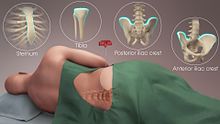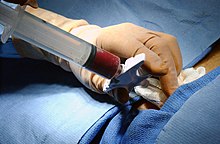Bone marrow examination
| Bone marrow examination | |
|---|---|
 | |
| MeSH | D001856 |
Bone marrow examination refers to the
Components of the procedure


Bone marrow samples can be obtained by aspiration and trephine biopsy. Sometimes, a bone marrow examination will include both an aspirate and a biopsy. The aspirate yields semi-liquid bone marrow, which can be examined by a
| Aspiration | Biopsy | |
|---|---|---|
| Advantages |
|
|
| Drawbacks | Does not represent all cells | Slow processing |
Aspiration does not always represent all cells since some such as
Site of procedure
Bone marrow aspiration and trephine biopsy are usually performed on the back of the hipbone, or posterior
Anesthesia is used to reduce surface pain at the spot where the needle is inserted. Pain may result from the procedure's insult to the marrow, which cannot be anesthetized, as well as short periods of pain from the anesthetic process itself. The experience is not uniform; different patients report different levels of pain, and some do not report any pain at certain expected points.[2]
Test performance


A bone marrow biopsy may be done in a health care provider's office or in a hospital.
Typically, the aspirate is performed first. An aspirate needle is inserted through the skin using manual pressure and force until it hits the
If several samples are taken, the needle is removed between the samples to avoid blood coagulation.
After the procedure is complete, the patient is typically asked to lie flat for 5–10 minutes to provide pressure over the procedure site. After that, assuming no bleeding is observed, the patient can get up and go about their normal activities. Paracetamol (aka acetaminophen) or other simple analgesics can be used to ease soreness, which is common for 2–3 days after the procedure. Any worsening pain, redness, fever, bleeding or swelling may suggest a complication. Patients are also advised to avoid washing the procedure site for at least 24 hours after the procedure is completed.
Contraindications

There are few
Complications
While mild soreness lasting 12–24 hours is common after a bone marrow examination, serious complications are extremely rare. In a large review, an estimated 55,000 bone marrow examinations were performed, with 26 serious adverse events (0.05%), including one fatality.[4] The same author collected data on over 19,000 bone marrow examinations performed in the United Kingdom in 2003, and found 16 adverse events (0.08% of total procedures), the most common of which was bleeding. In this report, complications, while rare, were serious in individual cases.[5]
Reference ranges for white blood cells in bone marrow
| Range (%)[6] | Reference range (%)[6] | Median (%)[6] | Mean (%)[6] | |
Erythroblasts (total) |
8.5–56.5 | 15.8–46.2 | 32 | 31.7 |
| Male | 11.0–54.5 | 16.2–46.6 | 33 | 32.4 |
| Female | 8.5–56.5 | 15.6–45.0 | 29.5 | 30.1 |
| Proerythroblast | 0–5.0 | 0–3.0 | 0.5 | 0.6 |
| Basophilic | 0–21.0 | 0.5–13.5 | 3.5 | 4.5 |
| Polychromatophilic | 3.0–47.0 | 7.8–34.5 | 20 | 20.2 |
| Orthochromatic | 0–21.0 | 0.5–16.5 | 5.5 | 6.3 |
Granulocytes (total) |
24.5–72.5 | 34.8–66.3 | 49.5 | 49.9 |
| Male | 26.0–70.5 | 35.5–64.5 | 49.5 | 49.7 |
| Female | 24.5–72.5 | 34.1–67.4 | 50 | 50.5 |
Neutrophils (total) |
||||
| Myeloblast | 0–8.5 | 0–5.0 | 1.5 | 1.6 |
| Promyelocyte | 0–8.5 | 0–5.5 | 1 | 1.3 |
| Myelocyte | 1.0–31.7 | 5.8–24.0 | 13.5 | 13.7 |
| Metamyelocyte | 0.5–18.0 | 1.0–12.0 | 4.5 | 5 |
| Band | 2.0–34.0 | 6.5–26.2 | 14.5 | 15.2 |
| Segmented | 1.0–27.5 | 2.5–19.7 | 9.5 | 9.8 |
Eosinophils (total) |
0–18.0 | 0.5–7.0 | 2.5 | 3 |
mast cells ) |
0–3.0 | 0–1.5 | 0 | 0.3 |
| GE-ratio | 0.5–5.9 | 0.8–4.1 | 1.6 | 1.7 |
Monocytes |
0–8.5 | 0–6.0 | 2 | 2.2 |
| ME ratio | 0.6–6.2 | 0.8–4.1 | 1.6 | 1.8 |
| Male | 0.6–6.1 | 0.8–4.0 | 1.6 | 1.8 |
| Female | 0.6–6.2 | 0.8–4.2 | 1.7 | 2 |
Lymphocytes |
1.0–38.5 | 5.5–23.2 | 13.2 | 13.6 |
| Plasma cells | 0–17.5 | 0–7.0 | 2.3 | 2.6 |
See also
References
- ^ a b eMedicine "Specialties > Hematology > Diagnostic Procedures > Bone Marrow Aspiration and Biopsy". Article last updated April 7, 2008.
- ^ What to Expect During a Bone Marrow Aspirate and Biopsy Archived 2016-03-04 at the Wayback Machine, Roswell Park Comprehensive Cancer Center, n.d. Accessed 2014-08-08.
- PMID 19812396.
- PMID 12786808.
- PMID 15790706.
- ^ PMID 32935189.) Attribution 4.0 International (CC BY 4.0) license
{{cite journal}}: CS1 maint: multiple names: authors list (link
